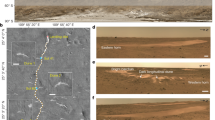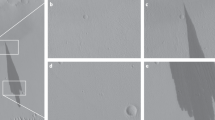Abstract
Since the first images of polar regions on Mars revealed alternating bright and dark layers, there has been speculation that their formation might be tied to the planet's orbital climate forcing1,2,3,4. But uncertainties in the deposition timescale exceed two orders of magnitude: estimates based on assumptions of dust deposition, ice formation and sublimation, and their variations with orbital forcing suggest a deposition rate of 10-3 to 10-2 cm yr-1 (refs 5, 6), whereas estimates based on cratering rate result in values as high as 0.1 to 0.2 cm yr-1 (ref. 7). Here we use a combination of high-resolution images of the polar layered terrains8, high-resolution topography9 and revised calculations of the orbital and rotational parameters of Mars to show that a correlation exists between ice-layer radiance as a function of depth (obtained from photometric data of the images of the layered terrains) and the insolation variations in summer at the martian north pole, similar to what has been shown for palaeoclimate studies of the Earth10,11,12. For the best fit between the radiance profile and the simulated insolation parameters, we obtain an average deposition rate of 0.05 cm yr-1 for the top 250 m of deposits on the ice cap of the north pole of Mars.
This is a preview of subscription content, access via your institution
Access options
Subscribe to this journal
Receive 51 print issues and online access
$199.00 per year
only $3.90 per issue
Buy this article
- Purchase on Springer Link
- Instant access to full article PDF
Prices may be subject to local taxes which are calculated during checkout



Similar content being viewed by others
References
Murray, B. C. et al. Geological framework of the south polar region of Mars. Icarus 17, 328–345 (1972)
Toon, O. B., Pollack, J. B., Ward, W., Burns, J. A. & Bilski, K. The astronomical theory of climatic changes of Mars. Icarus 44, 552–607 (1980)
Howard, A. D., Cutts, J. A. & Blasius, K. R. Stratigraphic relationships within martian polar-cap deposits. Icarus 50, 161–215 (1982)
Cutts, J. A. & Lewis, B. H. Models of climatic cycles record in Martian polar layered deposits. Icarus 50, 216–244 (1982)
Pollack, J. B. et al. Properties and effects of dust particles suspended in the Martian atmosphere. J. Geophys. Res. 84, 2929–2945 (1979)
Kieffer, H. H. H2O grain size and the amount of dust in Mars residual north polar cap. J. Geophys. Res. 95, 1481–1493 (1990)
Herkenhoff, K. & Plaut, J. J. Surface ages and resurfacing rates of the polar layered deposits on Mars. Icarus 144, 243–253 (2000)
Malin, M. C. & Edgett, K. S. Mars Global Surveyor Mars Orbiter Camera: Interplanetary cruise through primary mission. J. Geophys. Res. 106, 23429–23570 (2001)
Smith, D. E. et al. Mars Orbiter Laser Altimeter: Experiment summary after the first year of global mapping of Mars. J. Geophys. Res. 106, 23689–23722 (2001)
Hays, J. D., Imbrie, J. & Schackleton, N. J. Variations of the Earth's orbit: Pacemaker of the ice ages. Science 194, 1121–1132 (1976)
Imbrie, J. et al. On the structure and origin of major glaciation cycles: 1. Linear responses to Milankovitch forcing. Paleoceanography 7, 701–738 (1992)
Petit, J. R. et al. Climate and atmospheric history of the past 420,000 years from the Vostok ice core, Antarctica. Nature 399, 429–436 (1999)
Smith, D. E., Zuber, M. T. & Neumann, G. A. Seasonal variations of snow depth of Mars. Science 294, 2141–2145 (2001)
Blasius, K. R., Cutts, J. A. & Howard, A. D. Topography and statigraphy of martian polar layered deposits. Icarus 50, 140–160 (1982)
Haberle, R. M. & Jakosky, B. M. Sublimation and transport of water from the north polar residual cap on Mars. J. Geophys. Res. 95, 1423–1437 (1990)
Richardson, M. I. & Wilson, R. J. A topographically forced assymetry in the martian circulation and climate. Nature 416, 298–301 (2002)
Jakosky, B. M., Henderson, B. G. & Mellon, M. T. The Mars water cycle at other epochs: Recent history of the polar caps and layered terrain. Icarus 102, 286–297 (1993)
Cantor, B. A., James, P. B., Caplinger, M. & Wolff, M. J. Martian dust storms: 1999 Mars Orbiter Camera observations. J. Geophys. Res. 106, 23653–23687 (2001)
Laskar, J. The chaotic motion of the solar system. A numerical estimate of the size of the chaotic zones. Icarus 88, 266–291 (1990)
Standish, E. M. JPL Planetary and Lunar Ephemerides, DE405/LE405. (Jet Propulsion Laboratory Inter Office Memorandum, 312.F-98-048, 1998)
Folkner, W. M., Yoder, D. N., Yuan, E. M., Standish, E. M. & Preston, R. A. Interior structure and seasonal mass redistribution of Mars from radio tracking of Mars Pathfinder. Science 278, 1749–1752 (1997)
Laskar, J. & Robutel, P. The chaotic obliquity of the planets. Nature 361, 608–612 (1993)
Touma, J. & Wisdom, J. The chaotic obliquity of Mars. Science 259, 1294–1297 (1993)
Laskar, J. The limits of Earth orbital calculations for geological time scale use. Phil. Trans. R. Soc. Lond. A 357, 1735–1759 (1999)
Jakosky, B. M., Henderson, B. G. & Mellon, M. T. Chaotic obliquity and the nature of the Martian climate. J. Geophys. Res. 100, 1579–1584 (1995)
Thomas, P., Herkenhoff, K., Howard, A., Murray, B. & Squyres, S. in Mars (eds Kieffer, H. H., Jakosky, B. M., Snyder, C. W. & Matthews, M. S.) 767–795 (Univ. Arizona Press, Tucson, 1992)
Paige, D. A. & Ingersoll, P. Annual heat balance of Martian polar caps: Viking observations. Science 228, 1160–1168 (1985)
Martin, L. J. & Zurek, R. W. An analysis of the history of dust storm activity on Mars. J. Geophys. Res. 98, 3221–3246 (1993)
Zuber, M. T. et al. Observations of the north polar region of Mars from the Mars Orbiter Laser altimeter. Science 282, 2053–2060 (1998)
Acknowledgements
We thank F. Forget, A. Howard and B. Jakosky for useful discussions and suggestions, and A. Correia and M. Gastineau for their contribution to the obliquity solution. This work was supported by the CNRS-PNP and NASA Solar System Exploration programmes.
Author information
Authors and Affiliations
Corresponding author
Ethics declarations
Competing interests
The authors declare that they have no competing financial interests.
Rights and permissions
About this article
Cite this article
Laskar, J., Levrard, B. & Mustard, J. Orbital forcing of the martian polar layered deposits. Nature 419, 375–377 (2002). https://doi.org/10.1038/nature01066
Received:
Accepted:
Issue Date:
DOI: https://doi.org/10.1038/nature01066
This article is cited by
-
Martian dunes indicative of wind regime shift in line with end of ice age
Nature (2023)
-
Observations of North Polar Region of Mars from the Mars Colour Camera Onboard Indian Mars Orbiter Mission
Journal of the Indian Society of Remote Sensing (2023)
-
North polar trough formation due to in-situ erosion as a source of young ice in mid-latitudinal mantles on Mars
Scientific Reports (2021)
-
Multiple subglacial water bodies below the south pole of Mars unveiled by new MARSIS data
Nature Astronomy (2020)
-
Evolution of the rheological structure of Mars
Earth, Planets and Space (2017)
Comments
By submitting a comment you agree to abide by our Terms and Community Guidelines. If you find something abusive or that does not comply with our terms or guidelines please flag it as inappropriate.



